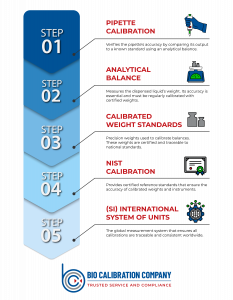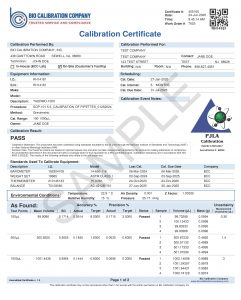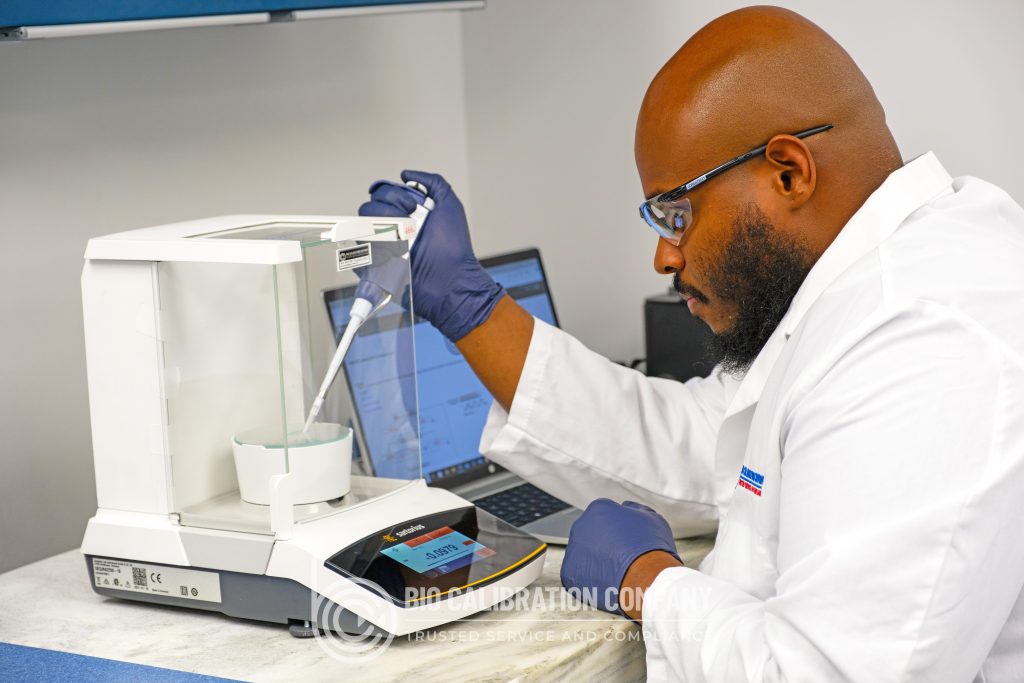
Importance of Measurement Traceability in Pipette Calibration

What is Measurement Traceability?
Measurement traceability provides evidence that a single or a set of measurements can be traced back to international standard units. This means that when you are measuring a certain quantity, the equipment or method you use to verify the value of that measurement can be linked to internationally accepted units, such as those defined by the International System of Units (SI). To the right is an image that demonstrates the concept of measurement traceability.
For example, when you calibrate a pipette, you might use an analytical balance to measure the weight of the liquid it dispenses. When calibrating a 1 mL pipette, verify the pipette’s performance by weighing the dispensed water and using the known density of water to calculate the accuracy of the volume. In this process, the balance used becomes the reference standard. To ensure the accuracy of measurements from the balance, it must be calibrated. But not just calibrated—it needs to have documentation that proves its readings are traceable back to SI units. This is often achieved by using calibration services that link the balance’s accuracy back through an unbroken chain of comparisons, each with known uncertainties, all the way to an international standard, such as NIST (National Institute of Standards and Technology).
This unbroken chain of documentation is what constitutes measurement traceability. Without it, you cannot guarantee that your pipette calibration is scientifically defensible or legally compliant.

Why is Measurement Traceability So Important?
Measurement traceability is crucial in pipette calibration for several key reasons: reliability, compliance, and confidence in the results.
Reliability and Accuracy
At the heart of traceability is the concept of trust. Can you trust that a 100 μL volume dispensed from a pipette is truly 100 μL? Without traceability, there’s no objective way to be certain. Every step in the calibration process—especially the equipment used to verify the pipette—must have proven accuracy through traceable calibrations. If your lab depends on precise volume transfers, such as in pharmaceutical or clinical testing, even minor errors can lead to flawed experiments or invalid data. In regulated industries, this can result in compliance issues or even public health risks.
Compliance with Industry Standards
For many industries, including biotech, pharma, and healthcare, regulatory standards require traceable calibrations. Organizations like the FDA, EPA, and ISO rely on traceability to ensure quality and consistency. If a company uses a calibration lab that can’t demonstrate traceability, they could fail audits or risk non-compliance with federal and international regulations.
Customer Confidence
Customers of pipette calibration labs—especially those in highly regulated industries—want more than just a calibration sticker on their equipment. They want documentation that proves the job was done correctly and that every measurement made during the process can be traced back to a known, reliable standard. Traceability provides customers with peace of mind, knowing that the data generated by their instruments is reliable. In other words, traceability is not just a technical requirement; it’s also a customer service feature that demonstrates your lab’s credibility and professionalism.
Without traceability, the customer has no way of knowing whether the calibration was performed correctly or if the equipment used was up to standard. This creates doubt—not only in the calibration, but in every experiment or test result that depends on that pipette.
Ways to Know If Calibrations Have Proper Traceability Based
on Calibration Certificates
So, how can you, as a customer, be confident that your pipette calibration includes proper traceability? Start with the calibration certificate.
Check for Reference Standards
A solid calibration certificate should list the reference standards used during the calibration process. If you see this, it’s a good sign that the lab is being transparent and thorough. These standards should include the model, serial number, and most importantly, the date of their most recent calibration.
Supporting Certificates Provided
We take it a step further by providing the calibration certificates of those reference standards. When reviewing the reference standards, make sure to look for mentions of traceability to national or international standards, such as NIST. These certificates should state clearly that the measurements are traceable to SI units, and they should include an uncertainty budget—another hallmark of a professional calibration.
Look for ISO/IEC 17025:2017 Accreditation
The most efficient way to ensure measurement traceability is to work with an ISO/IEC 17025:2017 accredited calibration laboratory. This standard is the international gold standard for calibration labs. ISO/IEC 17025:2017 accreditation requires that all measurements within a lab’s scope be traceable to international units. Labs undergo rigorous audits to prove their competence, and part of that includes demonstrating an unbroken chain of traceability.
When using an accredited lab for pipette calibration services, you don’t have to second-guess whether traceability has been established, it’s baked into the lab’s quality system. Most accredited labs will also show their accreditation certificate and scope publicly, so you can verify that they’re qualified to calibrate pipettes and other volume-related instruments.

Red Flags to Watch For
Be cautious of calibration labs that:

Conclusion
In the world of pipette calibration, measurement traceability is not optional, it’s essential. It serves as the backbone of any reliable calibration process, ensuring that each measurement can be traced to a known, documented, and internationally accepted reference point. Without it, you’re left with guesswork—and in regulated or high-precision industries, that’s not acceptable.
For customers, traceability offers confidence. It confirms that your pipettes are accurate, your measurements are reliable, and your lab is prepared to meet industry demands and audits. Whether you’re involved in research, diagnostics, manufacturing, or quality control, working with a calibration lab that provides documented traceability isn’t just best practice—it’s the smartest investment in data integrity you can make.
So next time you have your pipettes calibrated (either on-site or off-site), take a closer look at the certificate that comes back. Does it show traceability? Does it come from an ISO/IEC 17025:2017 accredited lab? If so, you can rest assured that your measurements are built on a foundation of verified accuracy. If not, it may be time to reevaluate your calibration partner.
